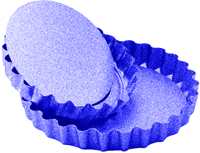
Silver anodised bakeware combines the excellent heat conducting properties of native aluminium without its disadvantages of softness and porosity. Anodising is an electro-chemical process that hardens the outer layer of the aluminium, giving it an easy-release, scratch resistant surface. It is more expensive than traditional tin-coated and non-stick coated steel, but its longevity and other advantages easily outweigh the additional cost.
Advantages • highly conductive - spreads and retains heat well. • heat efficiency much greater than other bakeware materials. • hard, firm, scratch-resistant surface that cannot peel or blister. • easy release properties without the application of a non-stick coating. • easy to clean. • will not rust. • there are no known health problems associated with anodised aluminium.
Disadvantage • cannot be cleaned in a dishwasher.
Use • anodised bakeware does not need to be seasoned before use - an initial wash in warm soapy water is all that is required. • when baking cakes, grease the pan lightly and dust with flour. Knock out excess flour before adding cake mix. • because the bakeware is so highly heat conductive, always check after 2/3 normal cooking time. • although anodised aluminium has a scratch resistant surface, it is advisable to avoid using sharp knives to cut flans, quiches and cakes in the pan. Cleaning • after use, wash in hot water and washing-up liquid, rinse and dry. • lightly burnt on residue can be removed by soaking the pan. • cooking with certain fats and oils may produce a slight change of colour on the surface of the pan that will not easily wash off. This is quite normal, is not hazardous to health and does not affect the performance of the bakeware. • do not wash in the dishwasher.
Silver Anodised Bakeware Information By: Blueshoots.com
Orignal Source : http://www.the-complete-cook-shop.com/

0 Comments:
Post a Comment
<< Home